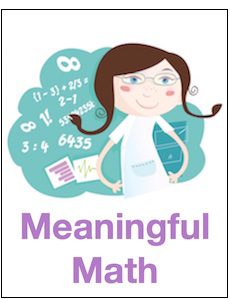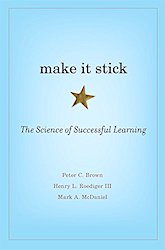Getting Math Students to Think for Themselves
A MiddleWeb Blog
 “I don’t know what to do.”
“I don’t know what to do.”
“I don’t even know where to start.”
“What’s it asking me to do?”
These are all comments I hear from my students on a regular basis. Some of students are reluctant to think for themselves. If they don’t immediately know the answer or what to do, they shut down.
Sadly, many times if students would just think about it, they do know what to do. Thinking and reasoning are skills that students will need for college, the workplace, and life in general, and I need to do a better job encouraging them to think for themselves.
Why Don’t Students Want to Think for Themselves?
I think that’s an important question, and I don’t usually think about it from the students’ perspective.
I’m sure that many times they shut down because they don’t want to be wrong, so by doing nothing it is at least not wrong. Students often tell me that they don’t start a problem because they are afraid that their answer will be wrong.
Sadly, what I can’t get them to understand is that being wrong in math is part of the process. It’s like putting together a puzzle: you do the wrong things first before you figure out the right things.
As much as I hate to admit it, part of the problem is that I’ve probably conditioned them to think that I’ll jump in quickly if they need help. As much as I value productive struggle, I also worry that they will feel discouraged or that we will run out of time before they can get to the answer on their own. I just feel the need to grab that pencil and start showing them how to do it! Our bad habits are hard to break.
Also, I will often provide step-by-step instructions which removes any responsibility from the student to think for themselves. A lot of this “scaffolding” I do for students occurs when I am trying to finish a unit or I know it’s a concept that students typically struggle with.
I’m trying to Improve!
I decided to start out my next unit (exponential functions) with an emphasis on students thinking for themselves. However, I didn’t have time to revamp my whole unit. Baby steps!
I typically introduce exponential functions by having students take notes about key features. Basically, I’m doing the telling. This time, instead, we started out looking at different tables of values and I asked them what they noticed.
What happened? I learned that asking students what they noticed is a pretty effective question. I asked students to talk with a partner (to decrease anxiety and to build confidence) about what they noticed and then I asked a few students to share. I think this would be a good strategy in middle as well as high school.
The students quickly noticed that the tables were from linear functions. We discussed how they could tell they were linear. We looked at several linear functions to make sure they were comfortable with identifying them. Students liked this part. They are very familiar with linear functions.
Then I showed them a table of values for exponential functions. Same question, “What do you notice?” Which led to “What kind of function is this?” Some of them had no experience with exponential functions. To their credit, they really tried to come up with it! Many students thought it was y =3x, and when they finally discovered it was y =3^x there was a gasp. It was wonderful!
As a side note, I used popsicle sticks to randomly call on groups to keep everyone engaged, but most students were interested and were calling out answers anyway. Most classes enjoyed the lesson, but one class completely shut down and became frustrated when asked to think and when they weren’t given steps and notes. It was really disappointing when the next day a student came up to me and said, “I hope you are going to teach today. I don’t learn like that.”

As we continued the unit, I looked for places students could be encouraged to think and reason and also work with each other. We use IXL at our school for practice problems, and typically I assign students an IXL that they work independently to reach a certain mastery level.
This time we worked each problem as a class, and I started out letting them confer with a partner until they got comfortable. Students would give an answer, and the class would debate whether it was correct or not. This resulted in a lot of thinking and good conversations. This seemed preferable to them working alone just randomly choosing an answer until they sort of came up with a pattern that worked without them really understanding why. Importantly, the students enjoyed it.
I also tried something called a row game. I found it on Kate Nowak’s site. The “row game” is a worksheet with two columns, A and B. Students work in pairs with one student working column A and the other column B. After each student completes their column, they compare answers. The pair of problems in each row will have the same answer. If students’ answers don’t match, they have to check each others’ work and look for the mistake.
When I did this in my class, I think it encouraged them to think for themselves. As I walked around, a couple of students asked me, “Is this the right answer?” I said, “check with your partner.” And they did! Having a partner and being able to self-check was the support many of my students needed to get started and stick with it.
I’m trying to think of other ways to encourage students to think without throwing them in the deep end. One of my teaching buddies has had a lot of success with students working at the board in teams to tackle challenging problems. I need to do more of that! One of my classes is too big for me to work out the logistics of working at the board, and I just got out of the habit of doing it all.
What I Have Learned:
⇒ Emphasis on problem solving and thinking needs to start day one, which I always intend to do, but I get side tracked sometimes.
⇒ When students have a partner to confer with, it seems to make them more willing to think and try things.
⇒ Starting out with something familiar and building to something else is helpful.
⇒ If you want students to think and reason, you have to give them the time and space to do it. Without my giving notes and step-by-step instructions, it took three days to fully introduce exponential graphs. I could have given them the notes in less than one day. I know which one is better, but it is a fact that allowing students to discover and think themselves will take longer.
⇒ Creating lessons that encourage students to think takes more time and skill is important.
What activities do you use in your classroom to encourage students to think? Please share in the comments below.
Edutopia has republished portions of this article.

































Great ideas for math implementation.
Super ideas,,,